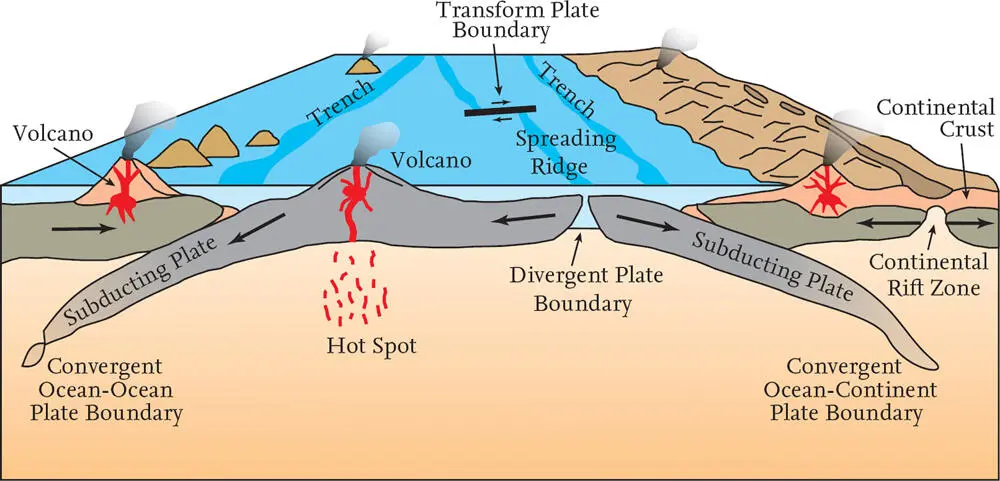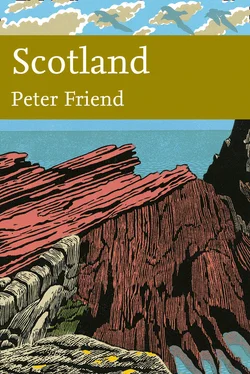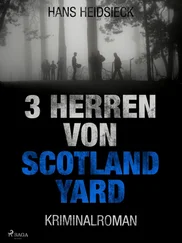
FIG 15. Diagram (not to scale) illustrating the movement processes of plates.
In other cases the plate boundary is divergent, where the neighbouring plates move apart and new material from deeper within the Earth rises to fill the space created. New oceanic crust is created by the arrival and cooling of hot volcanic material from below. The Mid-Atlantic Ridge running through Iceland is one of the examples nearest to Britain of this sort of plate boundary, and volcanic ash-cloud activity there caused widespread disruption to air transport during 2010.
Other plate boundaries, sometimes called transform boundaries, mainly involve movement parallel to the plate edges. The Californian coast zone is the classic example but there are many others, such as the transform boundary between the African and Antarctic plates. In some areas, plate movement is at an oblique angle to the suture and there are components of divergence or convergence as well as movement parallel to the boundary.
Britain today sits in the stable interior of the western Eurasian plate, almost equidistant from the divergent Mid-Atlantic Ridge boundary to the west and the complex convergent boundary to the south where Spain and northwest Africa are colliding. In its earlier history the crust of Britain has been subjected to very direct plate boundary activity. The results of convergent activity in Devonian and Carboniferous times (between 416 and 299 million years ago) are visible at the surface in southwest England, and in Ordovician to Devonian times (between 490 and 360 million years ago) in Wales, northwest England and Scotland (see Chapter 4).
Present-day plate boundaries are often picked out by the location of earthquakes, as described above. Mention should also be made at this point of the importance of volcanoes and igneous bedrock in providing information about movements within the upper levels of the Earth. Highly sophisticated analytical work has illuminated the whole subject of the chemical and mineral evolution of igneous material as it evolves and moves in the crust. For the purposes of this book, a very simple twofold division of igneous rocks into felsic and mafic will be sufficient.
Felsic igneous rocks tend to be light-coloured and of relatively low density, containing the minerals quartz and feldspar. Typical types are granite, syenite (coarsely crystalline) and rhyolite (finely crystalline). Continental crust consists of felsic and mafic igneous rocks, as well as sedimentary and metamorphic rocks.
Mafic igneous rocks tend to be darker-coloured and of relatively high density, containing feldspar and dark minerals rich in magnesium and/or iron, such as augite or hornblende. Typical types are gabbros (coarsely crystalline), andesites and basalts (finely crystalline). Oceanic crust is dominated by mafic igneous materials.
MAKING LOCAL MEASUREMENTS OF EARTH SURFACE MOVEMENTS
We have been considering the large movement systems that originate within the Earth. There are also more local movement systems operating on the Earth’s surface, which are linked to a very variable degree to the large-scale movements of plate tectonics. To explore this complex linkage further, it will be helpful to look now at different processes that may combine to cause particular local movements.
Tectonic plates are defined by their rigidity, so there is relatively little horizontal movement between points within the same plate, compared to the deformation seen in plate boundary zones. This extreme deformation may involve folding and fracturing of the rock materials, addition of new material from below, or absorption of material into the interior during subduction.
Nonetheless, deformation is not restricted solely to plate boundaries and does occur within the plates, although to a lesser extent. In some cases, major structures that originally formed along a plate boundary can become incorporated into the interior of a plate when prolonged collision causes two plates to join. The Caledonian convergent boundary that extended across Scotland (see Chapter 4) provides an excellent example of movements that occurred hundreds of millions of years ago, but also contains many examples of structures formed in later movements. These structures have often been reactivated long after they first formed in order to accommodate forces along the new plate boundary via deformation within the plate. Conversely, changes of internal stress patterns can sometimes lead to the splitting of a plate into two, forming a new, initially divergent plate boundary. Many of the oil- and gas-containing features of the North Sea floor ( Fig. 2) originated when a belt of divergent rift faults formed across a previously intact plate.
It needs to be stressed that the patterns of deformation (fracturing and folding) due to these plate motions occur at a wide range of different scales, from centimetres to thousands of kilometres. Sometimes they are visible at the scale of an entire plate boundary, such as the enormous Himalayan mountain chain that marks the collision of India with Asia.
The effects of features as large as plate boundaries on landscapes persist over hundreds of millions of years, long after the most active movement has ceased. For example, parts of southwestern England, Wales and the Scottish Highlands are underlain by bedrocks that were formed in convergent boundary zones of the past. The tin and lead mines of Cornwall owe their existence to a 300-million-year-old convergent plate boundary, where an ocean was destroyed as two plates converged and continents collided. The convergence released molten rock that rose in the crust and gradually cooled to form granite, whilst metals were precipitated in the surrounding crust as ‘lodes’ containing tin and lead (see Chapter 4).
Mapping the patterns of bedrock exposed at the surface often reveals folds and faults that provide key information about the movements that have taken place during the past ( Fig. 16). Figure 17provides a key to some of the terms commonly used to classify these structures, as a step towards understanding the sorts of movement patterns that they represent. In broad terms, folds tend to indicate some form of local convergent movement, though they may be the result of larger movement patterns of a different kind. Normal faults tend to indicate divergent or stretching movements, at least locally, whereas reverse and strike-slip faults tend to indicate convergence. Two broad types of fold are distinguished: synclines are U-shaped downfolds, while anticlines are the opposite – A-shaped upfolds.
Further mapping of folds and faults often reveals complex patterns of changing movements. A complex example is shown in Figure 18. Divergent movements in an area of crust produced plastic deformation in the warmer lower crust, and faulting into a number of discrete blocks in the colder, more brittle upper crust. This was then followed by an episode of convergent movement that resulted in closing up the upper crustal blocks and further flow in the plastic lower crust, causing crustal thickening and mountain building at the surface.
FIG 16. Outcrop in the Atacama Desert, Chile, showing a very regularly bedded succession of mudstones, formed originally as horizontally layered deposits in a lake. Since their deposition the mudstones have been tilted. They have also been fractured during an earthquake, resulting in a step, or normal fault (see Fig. 17), that is particularly clear because it has cut through a white layer in the deposits. An outcrop such as this makes it possible to measure the local movements that have taken place in this material after it was deposited. (© Nicholas Branson)
Читать дальше













